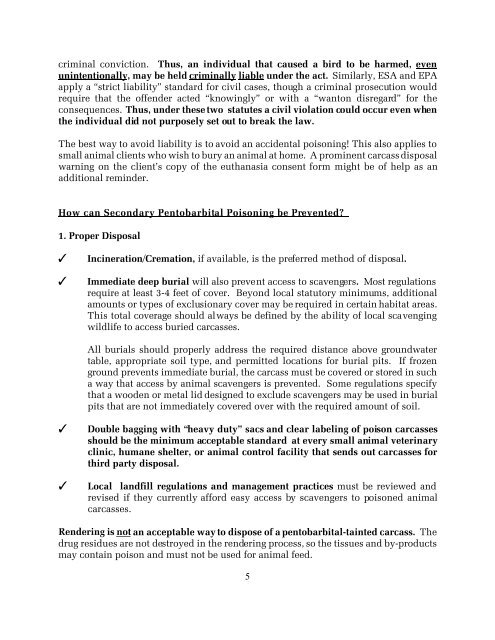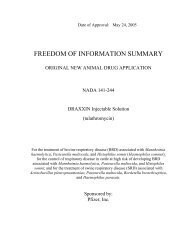Secondary Pentobarbital Poisoning of Wildlife - Veterinary Clinical ...
Secondary Pentobarbital Poisoning of Wildlife - Veterinary Clinical ...
Secondary Pentobarbital Poisoning of Wildlife - Veterinary Clinical ...
- No tags were found...
You also want an ePaper? Increase the reach of your titles
YUMPU automatically turns print PDFs into web optimized ePapers that Google loves.
criminal conviction. Thus, an individual that caused a bird to be harmed, evenunintentionally, may be held criminally liable under the act. Similarly, ESA and EPAapply a “strict liability” standard for civil cases, though a criminal prosecution wouldrequire that the <strong>of</strong>fender acted “knowingly” or with a “wanton disregard” for theconsequences. Thus, under these two statutes a civil violation could occur even whenthe individual did not purposely set out to break the law.The best way to avoid liability is to avoid an accidental poisoning! This also applies tosmall animal clients who wish to bury an animal at home. A prominent carcass disposalwarning on the client’s copy <strong>of</strong> the euthanasia consent form might be <strong>of</strong> help as anadditional reminder.How can <strong>Secondary</strong> <strong>Pentobarbital</strong> <strong>Poisoning</strong> be Prevented?1. Proper DisposalIncineration/Cremation, if available, is the preferred method <strong>of</strong> disposal.Immediate deep burial will also prevent access to scavengers. Most regulationsrequire at least 3-4 feet <strong>of</strong> cover. Beyond local statutory minimums, additionalamounts or types <strong>of</strong> exclusionary cover may be required in certain habitat areas.This total coverage should always be defined by the ability <strong>of</strong> local scavengingwildlife to access buried carcasses.All burials should properly address the required distance above groundwatertable, appropriate soil type, and permitted locations for burial pits. If frozenground prevents immediate burial, the carcass must be covered or stored in sucha way that access by animal scavengers is prevented. Some regulations specifythat a wooden or metal lid designed to exclude scavengers may be used in burialpits that are not immediately covered over with the required amount <strong>of</strong> soil.Double bagging with “heavy duty” sacs and clear labeling <strong>of</strong> poison carcassesshould be the minimum acceptable standard at every small animal veterinaryclinic, humane shelter, or animal control facility that sends out carcasses forthird party disposal.Local landfill regulations and management practices must be reviewed andrevised if they currently afford easy access by scavengers to poisoned animalcarcasses.Rendering is not an acceptable way to dispose <strong>of</strong> a pentobarbital-tainted carcass. Thedrug residues are not destroyed in the rendering process, so the tissues and by-productsmay contain poison and must not be used for animal feed.5



